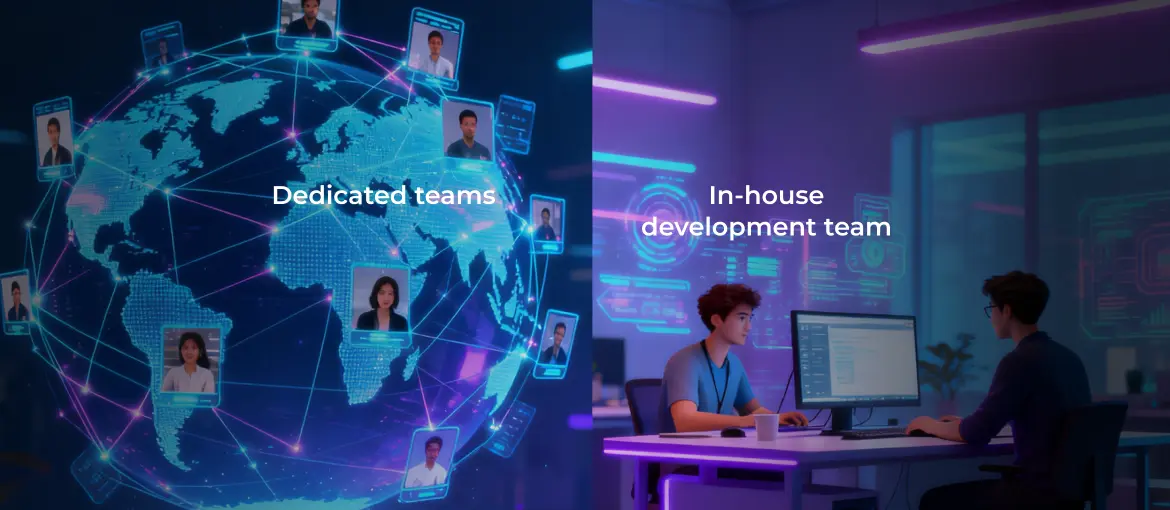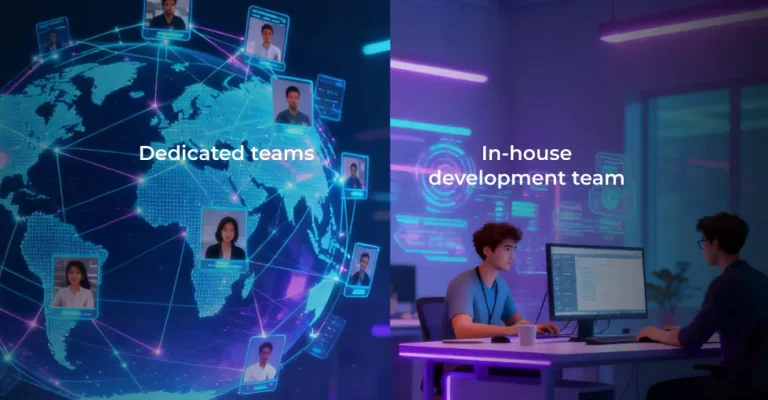Picture this: you’re Nick Fury assembling the Avengers. You need Iron Man’s cutting-edge tech expertise, Captain America’s strategic leadership, and Bruce Banner’s specialized scientific knowledge — all working together to save the world (or in your case, launch your product). But here’s the catch: do you hire each superhero full-time with benefits and a corner office at SHIELD headquarters? Or do you bring in a dedicated software development team that arrives fully formed, battle-tested, and ready to move from day one?
For the majority of companies, this is more than just a thought experiment — it’s a multimillion-dollar decision that could make or break their future. With 85.2 million unfilled software development positions projected by 2030 and AI talent demand exceeding supply, the global talent shortage is an existential threat to product roadmaps. Add to this software engineering salaries climbing 5.8% year-over-year to reach $82,536 for new graduates, and economic uncertainty forcing companies to optimize every dollar, and you’re facing a perfect storm of pressures.
What’s at stake? Companies choosing the wrong team model face:
- Cost overruns of 60-65% due to inefficient resource allocation and inflated local salaries
- Product launch delays of 3-6 months while waiting for recruitment and onboarding cycles to complete
- Missed market opportunities as competitors leveraging nearshore staff augmentation move faster and scale more efficiently
The right model choice depends on your project timeline, budget constraints, technical requirements, and growth trajectory. Some companies thrive with fully in-house teams. Others achieve better outcomes with dedicated external teams. Many find that a hybrid approach delivers optimal results.
This guide breaks down the main dedicated team vs in-house development questions and explores exactly when to choose each model.
Understanding the dedicated team and in-house development models
Before weighing the pros and cons of a remote dedicated team vs an internal team, let’s establish exactly what each model entails. While both approaches aim to deliver quality software, they differ fundamentally in structure, employment relationships, and operational frameworks.
| Factor | In-house development team | Dedicated nearshore team |
| Definition | Full-time internal employees hired, managed, and retained by the company. | A remote team provided by a nearshore partner, working exclusively for your project. |
| Employment model | Direct employment with salaries, benefits, taxes, and HR compliance. | Contract-based engagement through a vendor; no direct employment overhead. |
| Time to start | 1–4 months due to recruitment, interviews, notice periods, and onboarding. | 2–3 weeks, depending on required skills and team size. |
| Roles and responsibilities | Full product ownership, internal processes, and long-term continuity. | Delivery-focused execution, roadmap acceleration, and skill-specific support. |
| Control level | Daily oversight, cultural alignment, and management handled internally. | Operational control retained by the client; HR/admin handled by vendor. |
| Scalability | Limited by local talent pool, hiring capacity, and internal budget. | High, with rapid scaling up or down based on project demand. |
| Typical industries | Fintech, healthcare, gov-tech, cybersecurity. | E-commerce, SaaS, AI/ML, startups, and digital transformation projects. |
| Best use cases | Sensitive IP and regulated data. | Rapid product launches, team scaling, niche expertise, and cost optimization. |
Digging deeper into the differences
Understanding how to compare in-house and dedicated teams from a business perspective requires examining the practical implications of each model across critical operational dimensions. These differences manifest daily in how teams work, how budgets are allocated, and how quickly companies can respond to changing demands. Let’s explore the key distinctions that directly impact your project success and bottom line.
1. Employment type and control
In-house teams operate under direct W-2 employment contracts and are fully integrated into the organization. You control every aspect: hiring criteria, daily tasks, performance management, career development, and termination decisions. Your internal managers supervise work directly, conduct performance reviews according to company standards, and integrate developers into the broader organizational hierarchy. This complete control comes with complete responsibility for HR administration, benefits management, and compliance with employment regulations.
Dedicated nearshore teams work through contract-based partnerships where you maintain technical control while the vendor handles administrative overhead. You direct the work — defining requirements, prioritizing features, approving designs — but don’t manage HR functions like payroll, benefits, or vacation scheduling. The partnership operates through collaborative oversight: you assign a product owner who works directly with the team, while the vendor provides project management support and handles employment logistics.
Scenario snapshot: when your lead developer leaves unexpectedly, an in-house model means you personally manage the recruitment process, interview candidates, negotiate offers, and wait up to 4 months for a replacement. With a dedicated team, you get notified by your partner on Monday, review replacement candidates by Wednesday, and have a new developer onboarded within weeks — no job postings, no interview marathons, no salary negotiations.
2. Cost structure
The total cost of ownership reveals stark differences that extend far beyond the base salary listed on job postings.
In-house total cost breakdown
Base salaries
- US-based developers earn between $100,000 and $180,000 per year on average, with senior specialists commanding even higher salaries
- Tech hubs like San Francisco, NYC, and Seattle command $160,000 to $250,000 annually, while mid-tier cities like Austin, Denver, and Chicago range from $120,000 to $170,000
Benefits and overhead
- Health insurance, dental, and vision
- 401(k) matching and retirement contributions
- Paid time off and holidays
- Payroll taxes and workers’ compensation
- Remote work stipends and equipment allowances
Recruitment costs
- External recruiters typically charge 15-25% of the candidate’s annual salary; for a $150K hire, that’s up to $37,500 in recruiter fees alone
- In-house HR and recruiters cost $10,000 to $30,000 per hire, while technical talent platforms add 10-20% additional service fees
- Job board fees: posting on platforms like LinkedIn or Indeed costs up to $1,000 per post on average
Onboarding and training
- Formal onboarding costs average $4,100 per new hire
- Training expenses average approximately $1,111 per employee
- New hires take 8 to 26 weeks to reach full productivity; at $15,000/month total compensation and 50% capacity, that’s $7,500/month in lost productivity for three to six months
Infrastructure
- Workspace allocation (office space, utilities)
- Equipment (laptops, monitors, peripherals)
- IT support and system administration
Retention and turnover costs
- Average software engineer tenure is approximately 16 months to 2 years, with 69% staying less than 2 years
- Replacing an employee can cost 50-60% of their annual salary
- Knowledge loss and project disruption during transitions
Dedicated nearshore cost breakdown
Transparent rates
- Monthly or hourly billing with no surprise charges
- Outsourcing done well can reduce development costs by 20-50% or more compared to hiring locally
- All costs bundled: salary, benefits, infrastructure, management
Minimal recruitment investment
- Vendor manages sourcing and vetting
- No recruiter fees or job board expenses
- Access to pre-screened talent pools
Included infrastructure
- Development environments pre-configured
- All software licenses vendor-managed
- Project management tools and oversight included
Flexible scaling
- No severance obligations or layoff complications
- Pay only for active development time
Scenario snapshot: your SaaS company needs to build a mobile app alongside your existing web platform. If you choose the in-house route, the timeline quickly adds up: securing headcount approvals, posting jobs, and waiting for applicants can take 3–5 weeks at a reasonably fast-paced company, with 3–4 more weeks needed for interviewing and assessments. This is followed by offer negotiations and waiting for the new hires’ notice periods, which often add 2–4 more weeks.
With a nearshore dedicated team, the ramp-up looks very different. The vendor handles recruiting and assembling a group of engineers from an existing base of pre-vetted, highly motivated candidates, with some experts available from an internal pool. In the best-case scenario, you can finalize requirements early in the week, review curated team profiles within days, and begin structured onboarding almost immediately.
3. Scalability and flexibility
The ability to scale your team up or down directly impacts how fast you can capitalize on opportunities or weather market shifts.
In-house scaling constraints
- Timeline: median time to hire a software developer is 41 days
- Process bottlenecks: requisition approvals, budget cycles, interview scheduling, offer negotiations
- Capacity limits: can’t scale beyond what your recruiting and HR teams can process
- Downward inflexibility: layoffs require severance, legal considerations, and negative publicity
Dedicated team agility
- Rapid scaling: add 2-5 developers within 2 weeks
- Elastic capacity: scale down without HR complications or severance costs
- Seasonal flexibility: ideal for handling e-commerce traffic peaks such as Black Friday and holiday sales
- Test-and-learn: start with 2-3 developers, scale to 15+ if successful
Scenario snapshot: your Series B SaaS company lands a major enterprise client requiring custom integrations delivered in 90 days. If you don’t have the resources, an in-house approach means rejecting the opportunity or burning out your existing team. Dedicated team approach: spin up a 5-person integration squad in 2 weeks, deliver the project, then scale back to a 2-person maintenance team — extracting maximum value without long-term overhead.
4. Expertise and talent access
In-house teams typically rely on the local talent market — and in competitive regions like the U.S., UK, or EU, senior engineers are expensive and scarce. Dedicated nearshore teams tap into global talent pools, which can be especially valuable when niche, hard-to-find expertise is required.
Scenario snapshot: a healthtech firm needs several LLM-focused ML engineers for 6–9 months to integrate AI features. Local candidates want full-time roles with high compensation. A nearshore partner supplies thoroughly vetted ML engineers in just a few weeks.
5. Communication and collaboration
How teams coordinate work fundamentally differs between co-located and distributed models.
In-house communication dynamics
- Synchronous by default: walk over for quick questions, spontaneous whiteboard sessions
- Cultural alignment: shared company culture, values, and communication norms
- In-person benefits: body language, easier relationship building, office camaraderie
- Proximity dependence: remote-first in-house teams face similar challenges as external teams
Nearshore structured remote communication
- Time zone advantage: 4 or more hours of real-time overlap daily
- Asynchronous efficiency: well-documented decisions, clear written communication, reduced meeting fatigue
- Higher dependence on having structured ceremonies: daily standups (15 min), sprint planning, demos, retrospectives
Scenario snapshot: your product manager has a critical question at 3 PM EST. With an in-house team, you can walk to their desk in less than 5 minutes. With a nearshore team in LATAM, a Slack message gets a response in 10 minutes.
6. Security, confidentiality, and IP protection
Data control and intellectual property management require different approaches depending on team structure.
In-house security and IP control
- Direct oversight: physical security, access controls, and device management are all internally managed
- Data locality: sensitive data never leaves the company infrastructure
- Compliance simplicity: easier HIPAA, SOC 2, FedRAMP compliance with on-premises control
- IP ownership: clear, automatic work-for-hire with W-2 employees
Nearshore vendor-managed security
- Contractual protections: comprehensive NDAs, IP assignment agreements, confidentiality clauses
- Certifications: verify ISO 27001, SOC 2, and GDPR compliance from reputable vendors
- Code ownership: ensure that contracts explicitly assign all IP rights to you
- Repository access: your GitHub organization, your infrastructure, your data
- Security audits: right to audit vendor security practices and infrastructure
- Geographic considerations: data residency requirements may favor nearshore over offshore
Scenario snapshot: your healthcare tech startup builds patient engagement tools. Core HIPAA-compliant EHR integration stays in-house with cleared developers. A patient-facing mobile app, appointment scheduling, and telehealth video features are built by a dedicated nearshore team with appropriate BAAs and data segregation — balancing security with development speed.
7. Culture and accountability
How teams align with organizational values and demonstrate results differs significantly by model.
In-house organizational alignment
- Cultural immersion: daily exposure to company mission, values, and customer feedback
- Long-term thinking: employees invested in company success through equity, career growth
- Informal accountability: performance tracked through relationships, visibility, and annual reviews
- Team cohesion: natural bonding through shared office experiences, company events
Dedicated team performance framework
- Contractual accountability: SLAs define response times, code quality standards, and availability
- Metrics-driven: sprint velocity, story points completed, bug rates, code review turnaround
- Regular reporting: weekly status reports, sprint demos, burn-down charts
- Performance transparency: clear KPIs ensure alignment without physical proximity
- Team integration tactics: quarterly in-person meetings, virtual team building, and inclusive communication
Scenario snapshot: your VP of Engineering worries that a dedicated team won’t be as emotionally invested as internal employees. But the right vendor handpicks experts who know your industry, relate to your challenges, and genuinely care about your product’s success.
You can deepen this connection by involving them in monthly customer demo sessions, giving them access to your company’s Slack and all necessary documentation. You can also consider flying them to your headquarters or visiting their R&D hub once a year for strategic planning and team bonding.
When to choose which model
Choosing between a dedicated team vs an in-house development model isn’t about which one is “better” — it’s about which one aligns with your product, timeline, risk tolerance, and growth strategy. Below are clear, scenario-based guidelines to help CTOs, founders, and PMs make the right call.
When to choose in-house development
An internal team is the right choice when the work is deeply tied to your company’s long-term vision, requires high confidentiality, or demands close cross-functional alignment.
Best fit for:
- Long-term, mission-critical projects where continuity and deep product ownership matter the most
- Highly sensitive IP, such as proprietary algorithms, fintech engines, or AI cores
- Companies with highly predictable development pipelines and ample engineering resources
- Organizations that require high cross-team collaboration, such as enterprise ecosystems
- Products where domain knowledge builds a competitive advantage
When to choose dedicated nearshore teams
A dedicated team excels when speed, specialized expertise, and flexible scaling are essential. This model is especially attractive for startups and high-growth companies that need predictable delivery without the burden of hiring.
Best fit for:
- Projects requiring niche talent or experts that are hard to attract or retain locally
- Companies experiencing fluctuating workloads, seasonal spikes, or multiple parallel initiatives
- Startups moving fast toward MVP or product-market fit
- Scale-ups entering growth phases needing extra engineering power
- Long-term development when you want a strategic partnership but not full-time headcount
- Companies seeking to optimize costs or accelerate delivery on certain workstreams or projects
| Important note: A dedicated team can absolutely be a long-term partner — many companies maintain collaborations of 3–10 years or more with nearshore engineering teams. Longevity depends on selecting the right vendor — here’s a guide to choosing one. |
Hybrid approach: the strategic middle ground
The hybrid approach combines the strengths of both models: in-house ownership + nearshore execution power. This model has long established itself as the preferred structure for technology-intensive companies, and it’s reemerging as businesses tackle the diverse economic pressures of 2025–2026. Here’s why companies are increasingly leveraging hybrid delivery approaches:
1. Risk distribution and knowledge continuity. Hybrid approaches mitigate single-point-of-failure risks inherent to fully external or fully internal models. If your dedicated team partner experiences disruption, your in-house core team can maintain continuity. If in-house recruitment stalls, your external capacity sustains momentum.
2. Optimal resource allocation. Not all work involves the same level of organizational integration depth or IP sensitivity. Hybrid models enable you to match team type to work type, deploying expensive in-house resources where they add maximum value, while leveraging cost-effective external teams for important but less strategic work.
3. Flexibility without instability. Maintain a stable in-house foundation that provides organizational memory, cultural continuity, and strategic direction while scaling external capacity up and down to match project phases, market conditions, and budget cycles. This combination delivers predictability where needed and agility where advantageous.
4. Accelerated capability development. Hybrid teams enable rapid skill acquisition without waiting for hiring or training. Need blockchain expertise for a pilot project? Add three nearshore specialists to your in-house team rather than spending 3 months recruiting and 3 more months training. The in-house team learns through collaboration while delivery continues uninterrupted.
Hybrid model structures
Different hybrid configurations optimize for different organizational needs. Here are a couple of proven approaches:
Option 1: core + extension (30% in-house team, 70% remote dedicated team)
Best for: fast-growing startups, scale-ups, and established enterprises expanding or modernizing key product lines
In-house core:
- Product management and roadmap prioritization
- Technical architecture and engineering standards
- Core system development and critical IP
- Core DevOps and infrastructure
Remote team extension:
- Feature development
- QA and test automation
- CI/CD and routine DevOps tasks
- Integrations
- UI/UX design
- Maintenance, optimizations, and bug fixes
This hybrid setup ensures your in-house team focuses on strategy, innovation, and core IP while your nearshore team handles the tactical execution required to ship fast and scale sustainably. This strategy also allows you to move fast without overwhelming your local hiring pipeline or inflating operational costs.
Example: a cybersecurity enterprise keeps its threat intelligence algorithms, critical systems, and data, as well as research in-house (e.g., 8 engineers). In the meantime, their 12-person nearshore dedicated team builds the customer portal, reporting engine, admin console, and API suite, accelerating the company’s growth within its market niche.
Option 2: permanent + variable (baseline + flex)
Best for: companies with predictable baseline work and seasonal spikes
In-house team (permanent baseline):
- Core team sized for regular capacity needs
- Covers ongoing maintenance, support, and steady-state development for the core product
- Provides stability and institutional knowledge
Remote team (variable capacity):
- Scales up for new initiatives, such as building experimental features and products or custom internal tools
- Handles seasonal demand spikes (e.g., winter holiday period in e-commerce)
- Provides specialized expertise for time-limited projects (e.g., implementation of software needed to meet compliance deadlines)
This model optimizes cost efficiency by avoiding over-hiring for peak capacity while maintaining enough in-house expertise to ensure continuity during slow periods. E-commerce platforms scaling for Q4, financial services handling year-end reporting, and education technology preparing for back-to-school all benefit from this structure.
Example: an e-commerce platform maintains 6 in-house engineers year-round to ensure platform stability and build core features. The platform partners with a dedicated team to develop custom MarTech tools and e-commerce CRM functionality. It also engages additional remote developers from July through November to implement optimizations and client-facing solutions in time for the holiday season.
Conclusion
Choosing between a dedicated team vs in-house development is all about which model aligns with your timeline, budget, talent needs, security requirements, and long-term product strategy.
In-house teams give you deep cultural alignment, institutional knowledge, and long-term IP stewardship. Dedicated nearshore teams offer flexibility, cost efficiency, rapid scaling, and access to specialized global talent. For many companies, a hybrid approach offers the optimal balance of control and agility.
Ready to choose the right model for your next stage of growth?
Book a free consultation with our experts — we’ll help you evaluate your needs and outline the team structure that maximizes your product’s success in 2025–2026.
FAQs
1. Can a hybrid model work for my business?
Yes — hybrid models are becoming the default for many organizations. A hybrid setup allows you to retain core IP and product leadership in-house while scaling delivery capacity with a nearshore dedicated team. This approach reduces hiring pressure, shortens development cycles, and ensures continuity if team sizes need to expand or contract. Hybrid models work especially well for companies with fluctuating workloads, emerging tech initiatives, or fast-growth product roadmaps.
2. What happens if the dedicated nearshore team model doesn’t work out — can I switch?
Absolutely. Reputable vendors structure contracts to support flexible exits and smooth transitions. If you decide to pivot to in-house or hybrid, you should expect the following:
- Clear exit strategies are defined in the contract
- Knowledge transfer protocols ensure that code, documentation, and system access are fully handed over
- Transition planning to minimize delays or outages
- Scalable engagement models that allow you to downsize, switch models, or move to staff augmentation
A strong partner will help you transition without knowledge gaps or operational disruption — not lock you in.
3. How do I evaluate whether a dedicated team provider is reliable?
Start by checking these essential criteria:
- Track record & case studies in your industry
- Engineering talent quality (top 1–5%, vetted through multi-step screening)
- Communication standards — English proficiency, overlapping hours, Agile practices
- Security compliance — ISO 27001, SOC 2, GDPR, NDAs, IP assignment
- Team retention rates and culture fit
- Scalability — can they add specialists quickly?
- Transparent pricing with no hidden fees
- Client reviews on Clutch, G2, or direct references
4. Is a dedicated team the same as staff augmentation?
They’re related — but not identical.
- Staff augmentation adds individual developers or specialists to your existing team. You manage them directly.
- Dedicated teams provide a fully assembled, cross-functional unit (engineers, QA, DevOps, PM) that works as an integrated extension of your organization.
In other words:
Staff augmentation = extra hands.
Dedicated team = fully operational engineering squad.
Dedicated teams are ideal for larger initiatives, consistent development pipelines, and long-term scaling. Staff augmentation is effective for quickly filling isolated skill gaps.













